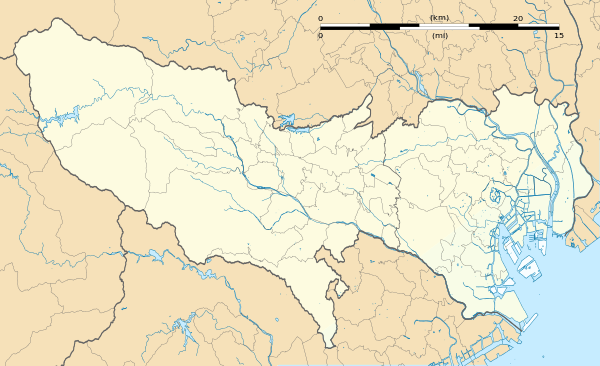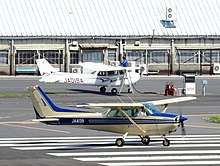Chōfu Airport
Chōfu Airport (調布飛行場, Chōfu Hikōjō) (ICAO: RJTF) is an airport located 1.2 NM (2.2 km; 1.4 mi) northwest[2] of Chōfu, Tokyo, Japan, west of central Tokyo. It is administered by the Bureau of Port and Harbor of the Tokyo Metropolitan Government. The airport's main commercial activity is New Central Airservice commuter flights to the Izu Islands south of Tokyo.
.jpg)
Chōfu Airport 調布飛行場 Chōfu Hikōjō | |||||||||||
|---|---|---|---|---|---|---|---|---|---|---|---|
 | |||||||||||
| Summary | |||||||||||
| Airport type | Public | ||||||||||
| Operator | Bureau of Port and Harbor, Tokyo Metropolitan Government | ||||||||||
| Location | Chōfu, Tokyo, Japan | ||||||||||
| Hub for | |||||||||||
| Elevation AMSL | 139 ft / 42 m | ||||||||||
| Coordinates | 35°40′18″N 139°31′41″E | ||||||||||
| Map | |||||||||||
 RJTF  RJTF | |||||||||||
| Runways | |||||||||||
| |||||||||||
| Statistics (2015) | |||||||||||
| |||||||||||
Source: Japanese Ministry of Land, Infrastructure, Transport and Tourism[1] | |||||||||||
History
Plans for Chōfu airfield were made in 1938. Construction started in 1939 and the airport opened in 1941. It had two runways, one of 1000 meters and one of 675 meters. During the Pacific war it was exclusively used by the Imperial Japanese Army Air Service.
The airfield was host to Kawasaki Ki-61 Hien fighters used for air defense against Boeing B-29 Superfortress bombing raids by the United States Army Air Forces (USAAF).
In 1944 a number of concrete hangars were built to protect the aircraft from air attacks. Two of these are preserved in what is now a small park to the east of the current airport.
Occupied after the war by American forces, the airfield was briefly used as a base for Lockheed F-5 Lightning photo-reconnaissance aircraft of the 6th and 71st Reconnaissance Groups beginning in late September 1945, mapping the extent of wartime damage over Honshū. The mapping flights ended in January 1946, ending operational military use by the Americans. The USAAF saw no need for the facility, especially given its proximity to the densely populated urban area. It was turned over to the occupation government in 1946, eventually being returned to Japanese control.

Current users
The airport is currently used by a number of companies including Aerotec, Jamco,[3] Toho Air Service, Tokyo Airlines[4] and New Central Airservice.
The airfield is also used by the National air and space agency JAXA which headquarters is located here. The Chōfu Aerospace Center serves as JAXA's major research and development base. As a focal point of aeronautical research and development in Japan, the center plays an important role in supporting and leading the growth of the Japanese aviation industry.[5]
Like many Japanese airports, it has an observation area. There is an observation deck located on the second floor of the terminal. In addition there is a platform and a number of mounds located in the nearby parks.

Airlines and destinations
| Airlines | Destinations |
|---|---|
| New Central Airservice | Kōzushima, Miyakejima, Niijima, Oshima |

Accidents and Incidents
- On March 23, 1976, Mitsuyasu Maeno, a young right-wing nationalist and actor, took off from Chōfu Airport on a self-inspired kamikaze mission into the house of Yoshio Kodama, a Japanese organized crime figure linked to the Lockheed Scandal. Maeno felt that Kodama facilitating bribes from the American aircraft company was a betrayal of right-wing values. Maeno was killed and two of Kodama's servants were injured. Kodama was uninjured.[6]
- On August 10, 1980, a private plane crashed into the playground of Chōfu Junior High School after take-off, killing everyone on board.[7][8]
- On July 26, 2015, a Piper PA-46 Malibu piloted by Taishi Kawamura and carrying four passengers on board, crashed into a residential area just after take-off. Three people died in the crash, including the pilot, one of the passengers, and a woman on the ground. The other three passengers survived with injuries, as did two people on the ground. Witnesses on the ground reported that the engine made an abnormal sound as it flew over them. Several videos were uploaded to YouTube showing the airplane flying lower than usual after take-off. Three investigators from the Japan Transport Safety Board were soon dispatched to the accident site. The Tokyo Metropolitan Police Department also launched an investigation, suspecting professional negligence resulting in injury and death. Initial investigative work revealed the airplane was involved in a landing incident at an airport in Hokkaido in October 2004. Several anomalies with the flight plan were also found. Media speculations suggested the engine or professional negligence as likely causes of the crash.[7][9]

References
![]()
- "Chofu Airport" (PDF). Japanese Ministry of Land, Infrastructure, Transport and Tourism. Archived from the original (PDF) on 21 October 2016. Retrieved 7 January 2017.
- AIS Japan
- JAMCO Retrieved March 29, 2017 (in Japanese)
- Tokyo Koku Retrieved March 29, 2017 (in Japanese)
- JAXA Headquarters Office / Chofu Aerospace Center Retrieved March 29, 2017
- Cohen, Jerome Alan Japan's Watergate: Made in U.S.A November 21, 1976 New York Times Retrieved April 11, 2017
- Police suspect engine trouble in fatal Chofu plane crash July 17, 2015 Japan Times Retrieved September 30, 2016
- Accident report Retrieved September 30, 2016 (in Japanese)
- ASN Wikibase Occurrence # 178067 July 26 2015 Aviation Safety Network Retrieved March 15, 2017
External links
| Wikimedia Commons has media related to Chofu Airport. |
- Chōfu (in Japanese) Ministry of Land, Infrastructure and Transport (Japan) Tokyo Civil Aviation Bureau
- Chōfu Hikōjō Mondai (in Japanese)
- Malibu.jp web site describes the fliers club and on airport "Propeller Cafe" (Japanese).